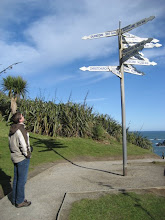After reading a book with scenes in Africa, and another set in Africa, I decided to post memories and stories as well as photographs of my trip there. These are more stories of Kilimanjaro.
High altitude climbing is interesting. I have since decided (after climbing Mount Adams when I was out of shape) that I prefer streams and trees to rocks and snow. While the equatorial location of Mt. Kilimanjaro may make the temperature at higher elevations more like lower elevations elsewhere, I don't imagine there's any more oxygen.
A sign at Marangu Gate had some reference elevations. From Marangu Gate we climbed to our first stop, Mandara Hut. In regard to oxygen, I don't think anyone had too much difficulty at Marangu Gate (1 970 m, higher than Denver) or Mandara Hut (2 700 m), though the climb was tiring and the air noticeably thinner on the way.
Several people climbing Kilimanjaro at the same time I was—including two American doctors and some Austrian gentlemen—took Diamox to assist in acclimation. Ashley, a young woman who was part of a British couple climbing alongside me, starting taking it at Kibo Hut. Apparently it alters the oxygen dissociation curve so that hemoglobin will release oxygen more readily.
Additionally, many people—including me—stayed two days at Horombo Hut, taking an extra day to attempt to acclimatize. I'm told most people notice the effects of lack of oxygen due to altitude at around 3 000 m. Horombo Hut is at 3 720 m. After lunch there, we climbed up to the saddle between the two prominent volcanic peaks, Mawenzie and Kibo. On the way to the saddle, at 4 500 m, is Zebra rock.
While I was at Horombo Hut, one German young man was removed from Mt. Kilimanjaro in a stretcher, a victim of High Altitude Pulmonary Edema (HAPE), or fluid on the lungs. While some climbers asserted that they saw him alive at lower elevation, one American doctor also making the climb, who watched him pass in the stretcher, was convinced that he died before reaching the bottom. The Segmans, whom I met at Horombo Hut, corroborated this after returning to the park headquarters at Marangu Gate.
Apparently the young man had been sick at Horombo and Kibo Huts, and perhaps even at Mandara Hut. It may have been merely traveler's diarrhea, but dehydration might be deadly if one's body begins to retain water as in pulmonary edema.
While the climbers were abuzz with this news, I overheard one climber who reached Gilmans Point on the crater rim being asked if he had had any trouble. He said he had many symptoms: headache, dizziness, and hallucinations. I would not have persisted if I had experienced the latter, a symptom of High Altitude Cerebral Edema (HACE), or swelling of the brain.
They don't publicize the statistics, but my informal and anecdotal survey suggests that on the order of 1000's attempt Mt. Kili, 100's actually arrive at the crater rim, and 10's die. I heard that eight people died in December during the millennial climb. One woman died of HAPE on January 1, after she and her husband insisted on continuing to climb against their guide's recommendation.
